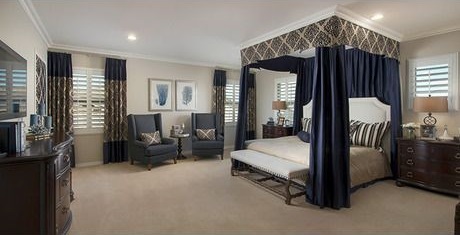
White? Green? Brown? Shocking pink?
Whatever the choice, colors have an impact. That’s why most new homebuyers enjoy selecting the colors that will define the look of their new home.
For those who have the means to build a completely custom house, the sky’s the limit with respect to color choices. For those who purchase a resale home, whatever the former owner liked is what the next buyer will get.
Between those two is the newly built house, which offers buyers a limited number of pre-determined colors for paint, trim, front door, roof tiles, cabinets, countertops and more. The options are many, though not enough to overwhelm most buyers’ ability to decide.
Community Colors
Builders give a lot of thought to exterior color schemes that are aesthetically pleasing and likely to appeal to the most people, says Royal Erickson, director of national contracts at Meritage Homes based in Scottsdale, Ariz.
The goal is to create a sense of community.
“The colorists put together a scheme that has a certain siding color or stucco color that matches the trim that matches the roof and the stone. The idea is that it all blends together and looks great. It’s not the bright red house next to the florescent green house,” Erickson says.
Buyers might be surprised to learn that while builders offer multiple exterior color options, they don’t always have free reign to offer whatever colors they want.
Rather, “a broad range of variables come into play,” says Janice Jones, vice president of merchandising for Buckhead, Ga.-based Pulte Group’s interior design team.
One variable might be the guidelines of the community where the homes will be built.
“More than half the time, the builder has to work in association with a developer or master-planned community,” Jones says. “Municipalities potentially weigh in as well. They don’t want one builder doing something completely off base compared to the other builders.”
All that means buyers will have exterior color choices, but the colors won’t be unlimited. More likely, they’ll come in coordinated packages from which buyers can select a scheme they like.
Interior Trends
Inside the home, buyers typically can choose from many more colors, either in coordinated schemes or on an a la carte basis, Jones says. Some buyers want guidance. Others prefer to pick and choose on their own.
The coordinated options are based on extensive research into color trends and preferences. Designers look for trends everywhere: home products manufacturers’ surveys, home improvement websites, consumers’ picture-board websites and even home improvement TV shows, Jones explains.
The objective is to discern what’s current and decide what to offer, giving buyers what they want within the boundaries of what they can afford.
“We don’t want to overwhelm our customers with too many (options),” Jones says, “but we understand them well enough to know that if someone is buying a $700,000 home in Minnesota, which is almost semi-custom at a minimum, we have to offer a broader range of options, selections and upgrades compared to someone buying a $200,000 entry-level home in Texas. If we overwhelm them, not only are we getting out of their range of qualifying, but we’re also overwhelming them.”
What’s In — And What’s Out
Colors do come into style and go out of style over time.
In recent years, a traditional style with lots of golds, purples and rusty copper colors blended together has given way to a cleaner style with more contrast, such as cream or gray tones matched with red brick, Jones says.
“All that heavy old-world for new homes is getting cleaned up (and made) more simple, modern, yet classic, but not extremely modern,” she says.
Color Upgrades
New homes usually are sold with all the basics, plus different levels of upgrades, options or elevations that buyers can add on.
Color is one area where buyers are likely to get a lot of choices with little or even no difference in the cost. That might be because the builder’s own costs to offer one color or another for the identical item usually don’t differ that much.
Some colors might involve a premium, but typically it’s minimal, Erickson explains.
“When making that decision on what we are going to specify as far as color, cost is not a driving factor, but it is something we look at,” he says.
How to Choose
New home buyers are well-advised to steer clear of bright vivid colors, even if the builder gives them such options, says Moira O’Sullivan, an architectural colorist and consultant in San Anselmo, Calif.
“Color is very subjective and personal,” O’Sullivan says. “Look for colors that are fairly neutral, so when you move in you don’t feel like you don’t like a particular color.”
What colors comprise a neutral palette?
“A neutral palette would be nature-inspired colors, monochromatic, nothing that jumps out at you,” O’Sullivan says. “Builder Beige is fine for the first year because you really want to see what resonates with you.”
First-timer buyers should be especially cautious about color choices, because they might not have extra money to replace their existing furniture right away, she adds.
Buyers should be conservative with color choices for countertops, cabinets and wood flooring stains, because those components can be quite costly to change later, O’Sullivan says. Carpeting, window coverings and paint are, relatively speaking, less expensive to do over.
Buyers who aren’t ready to purchase permanent window coverings can create privacy by hanging paper shades (or the traditional bed sheets) over their windows.
The bottom line is that new homebuyers will find lots of colors on offer and plenty of guidance to help them choose. -- By Marcie Geffner from New Home Source
Interested in a new home? Please do not hesitate to call us at Landon Homes, (904)567-3430!
No comments:
Post a Comment